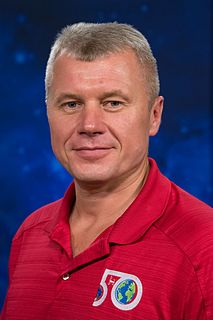
Oleg Viktorovich Novitskiy is a former Lieutenant Colonel in the Russian Air Force who logged over 700 hours of flight time and was awarded for bravery. He is currently serving as a Russian cosmonaut with Roscosmos and has participated in multiple expeditions, during which he has spent over 531 days in space.

Sergey Nikolayevich Ryzhikov, lieutenant colonel of Russian Air Force, is a Russian cosmonaut, selected in 2006. He is a veteran of two long duration space flights to the ISS.
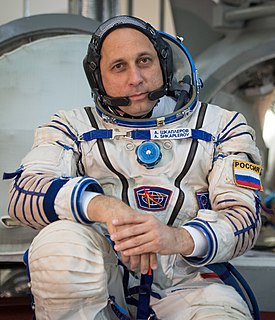
Anton Nikolaevich Shkaplerov is a Russian cosmonaut. He is a veteran of four spaceflights.

NASA Astronaut Group 20 saw the training of nine mission specialists, and five international mission specialists to become NASA astronauts. These 14 astronauts began training in August 2009 and officially graduated as astronauts on 4 November 2011.

Mark Thomas Vande Hei is a retired United States Army officer and current NASA astronaut who has served as a flight Engineer for Expedition 53, 54, 64, 65, and 66 on the International Space Station. He is married to Julie Vande Hei.
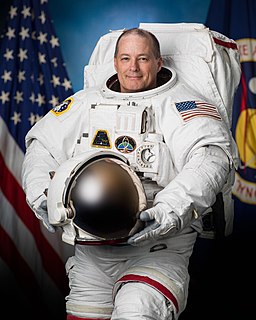
Scott David Tingle is a NASA astronaut. He was selected in June 2009 as a member of the NASA Astronaut Group 20, qualifying in 2011. Serving as a flight engineer as part of Expedition 54 and 55, Tingle launched into space on board Soyuz MS-07 in December 2017, and returned in June 2018. Tingle is a highly decorated naval pilot, having flown 51 types of aircraft over more than 4,500 flight hours, landed 750 aircraft with carrier arrestments, and fought in 54 combat missions.

Soyuz TMA-03M was a spaceflight to the International Space Station (ISS). It launched on 21 December 2011 from Site One at the Baikonur Cosmodrome, Kazakhstan, carrying three members of Expedition 30 to the ISS. TMA-03M was the 112th flight of a Russian Soyuz spacecraft, since the first in 1967, and the third flight of the modernised Soyuz-TMA-M version. The docking with the International Space Station took place at 19:19 Moscow Time on 23 December, three minutes ahead of schedule.

Anatoli Alekseyevich Ivanishin is a former Russian cosmonaut. His first visit to space was to the International Space Station on board the Soyuz TMA-22 spacecraft as an Expedition 29 / Expedition 30 crew member, launching in November 2011 and returning in April 2012. Ivanishin was the Commander of the International Space Station for Expedition 49.

Soyuz MS-04 was a Soyuz spaceflight that launched on 20 April 2017 to the ISS. It transported two members of the Expedition 52 crew to the International Space Station. Soyuz MS-04 was the 133rd flight of a Soyuz spacecraft. The crew consisted of a Russian commander and an American flight engineer. It was the first of the Soyuz MS series to rendezvous with the Station in approximately 6 hours, instead of the 2 day orbital rendezvous used for the previous launches. It was also the first Soyuz to launch with only 2 crew members since Soyuz TMA-2.

Soyuz MS-06 was a Soyuz spaceflight which launched on 13 September 2017. It transported three members of the Expedition 53 crew to the International Space Station. Soyuz MS-06 was the 135th flight of a Soyuz spacecraft. The crew consisted of a Russian commander, and two American flight engineers. It returned to Earth on 28 February 2018 after 168 days in orbit.

Expedition 52 was the 52nd expedition to the International Space Station. It officially began on June 2, 2017 10:47 UTC, with the undocking of Soyuz MS-03. Transfer of Command from Expedition 51 was done on June 1, 2017.
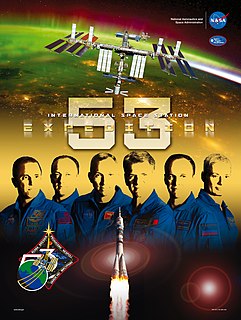
Expedition 53 was the 53rd expedition to the International Space Station, which began upon the departure of Soyuz MS-04 on September 2, 2017 and concluded upon the departure of Soyuz MS-05 on December 14, 2017. Randolph Bresnik, Paolo Nespoli and Sergey Ryazansky were transferred from Expedition 52, with Randolph Bresnik taking the commander role. Transfer of Command from Expedition 53 to Expedition 54 was done on December 13, 2017. Expedition 53 officially ended on December 14, 2017 5:14 UTC, with the undocking of Soyuz MS-05.

Expedition 54 was the 54th expedition to the International Space Station, which began upon the departure of Soyuz MS-05 on December 14, 2017 and concluded upon the departure of Soyuz MS-06 on February 27, 2018. Alexander Misurkin, Mark Vande Hei and Joseph Acaba were transferred from Expedition 53, with Alexander Misurkin taking the commander role. Transfer of Command from Expedition 54 to Expedition 55 was done on February 26, 2018. Expedition 54 officially ended on February 27, 2018 23:08 UTC, with the undocking of Soyuz MS-06.

Expedition 55 was the 55th expedition to the International Space Station, which began upon the departure of Soyuz MS-06 on February 27, 2018. Anton Shkaplerov, Scott D. Tingle and Norishige Kanai were transferred from Expedition 54, with Anton Shkaplerov taking the commander role. Expedition 55 ended upon the departure of Soyuz MS-07 in June 2018.

Soyuz MS-17 was a Soyuz spaceflight that was launched on 14 October 2020. It transported three crew members of the Expedition 63/64 crew to the International Space Station. Soyuz MS-17 was the 145th crewed flight of a Soyuz spacecraft. The crew consisted of a Russian commander and a Russian and American flight engineer.

Soyuz MS-18 was a Soyuz spaceflight that was launched on 9 April 2021 at 07:42:41 UTC. It transported three members of the Expedition 64 crew to the International Space Station (ISS). Soyuz MS-18 was the 146th crewed flight of a Soyuz spacecraft. The launching crew consisted of a Russian commander, a Russian flight engineer, and an American flight engineer of NASA. The spacecraft returned to Earth on 17 October 2021 following 191 days in space. The flight served as the landing vehicle for the Russian film director Klim Shipenko and actress Yulia Peresild who launched to the ISS aboard Soyuz MS-19 and spent twelve days in space in order to film a movie, Vyzov.

Soyuz MS-19 was a Soyuz spaceflight which launched on 5 October 2021, at 08:55:02 UTC. It was the 147th flight of a crewed Soyuz spacecraft. The launching crew consisted of Russian commander Anton Shkaplerov, Russian film director Klim Shipenko and Russian actress Yulia Peresild. Shipenko and Peresild spent about twelve days on the International Space Station before returning to Earth aboard Soyuz MS-18, while filming a movie in space, Vyzov. The MS-18 flight launched two crew members of the Expedition 66. Without an American astronaut, this launch marked the first time in more than 21 years that a Soyuz crew only included Russian cosmonauts and travelers and the ship had to be upgraded to be piloted by a single person at launch. This is also the first mission to the ISS with an entirely Russian crew.

Pyotr Valerievich Dubrov is a Russian engineer and cosmonaut selected by Roscosmos in 2012.

Expedition 66 was the 66th long-duration expedition to the International Space Station. The mission began after the departure of Soyuz MS-18 on 17 October 2021. It was commanded by European Space Agency astronaut Thomas Pesquet, the fourth European astronaut to command the ISS and first French astronaut to command the orbital laboratory, until 8 November 2021, when Russian cosmonaut Anton Shkaplerov, who arrived aboard Soyuz MS-19, and took over his command.
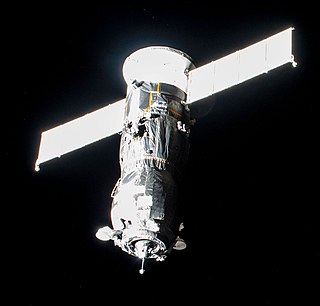
Progress MS-17, Russian production No. 446, identified by NASA as Progress 78P, was a Progress spacecraft launched by Roscosmos to resupply the International Space Station (ISS). This was the 169th flight of a Progress spacecraft.

























